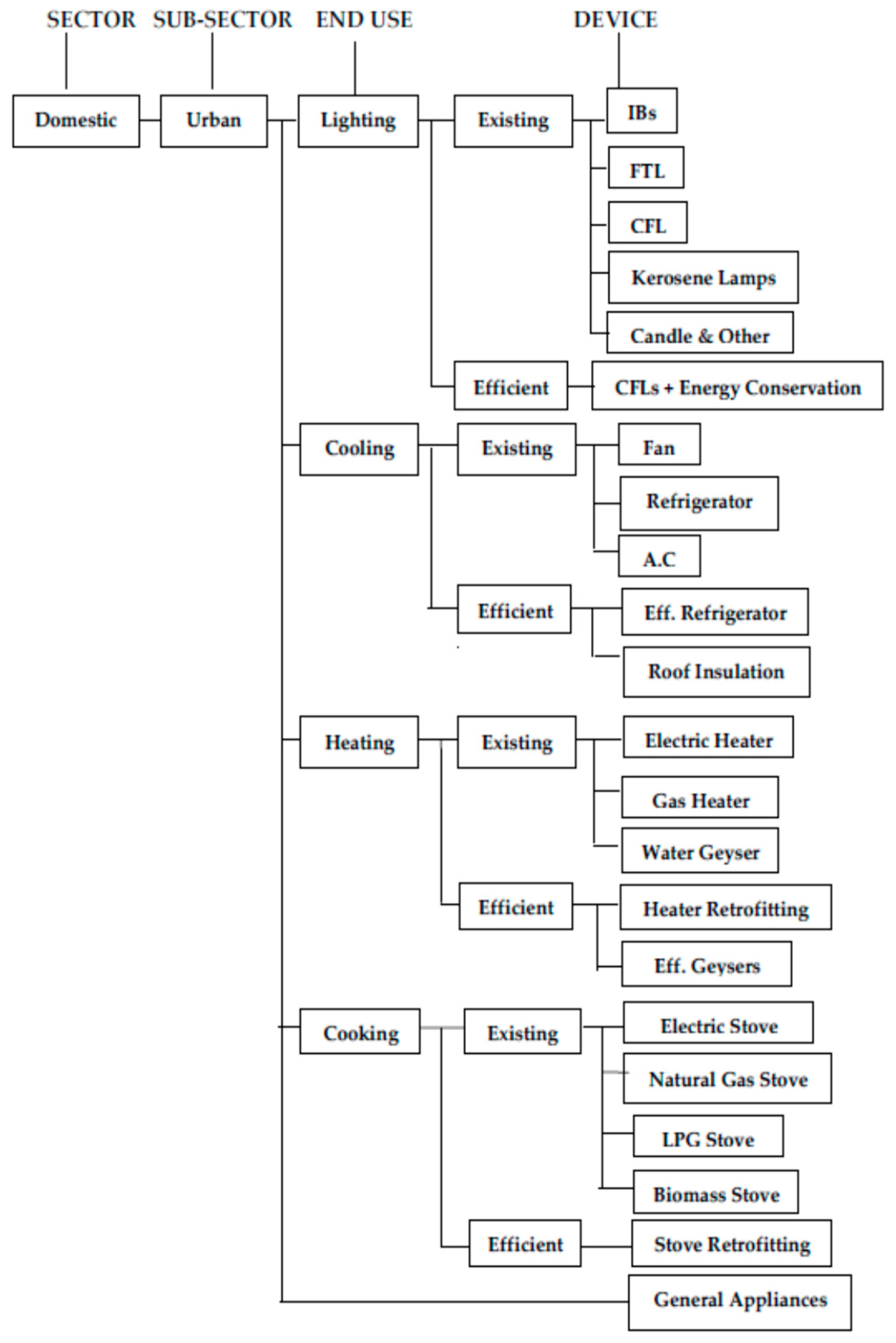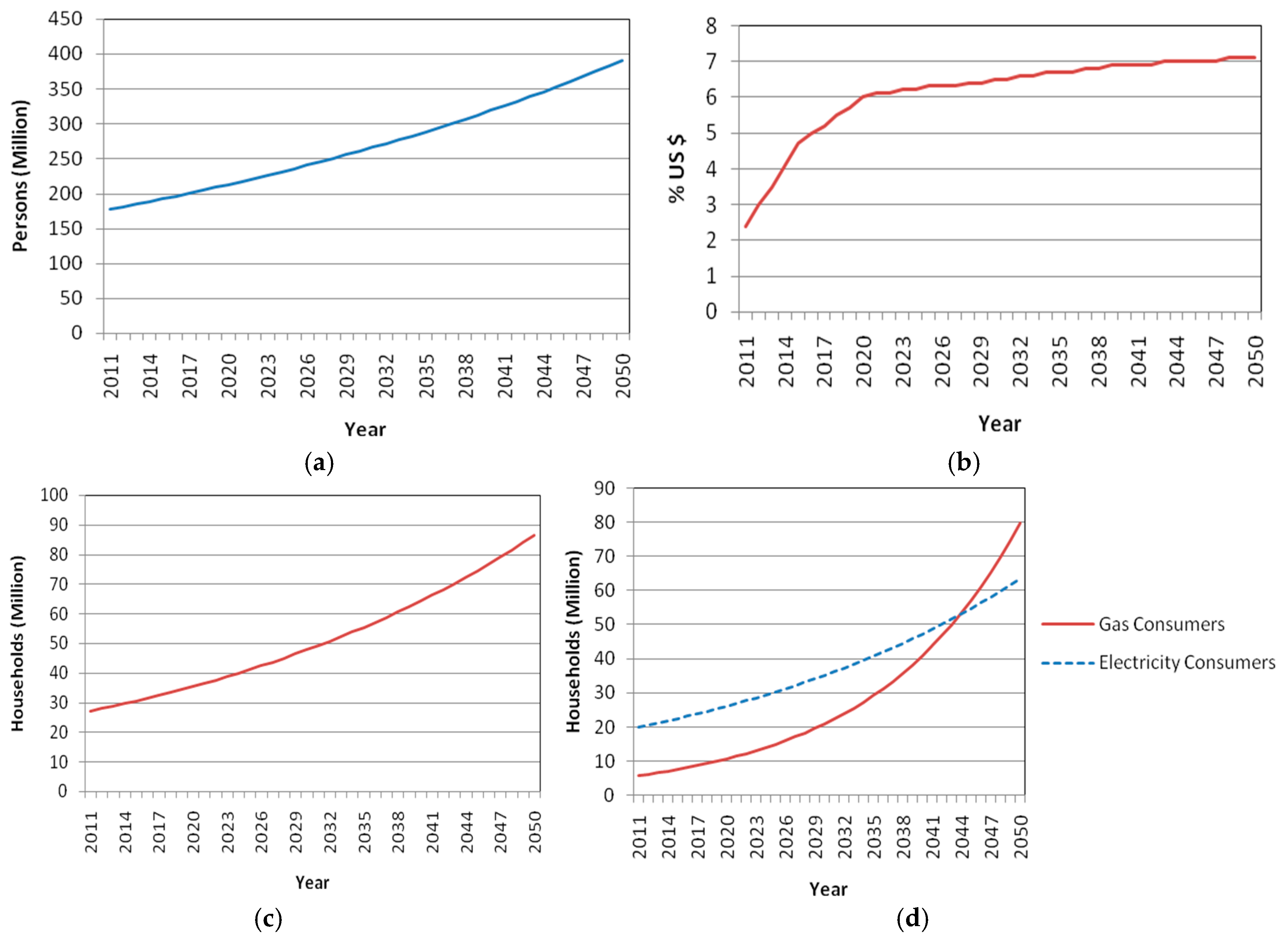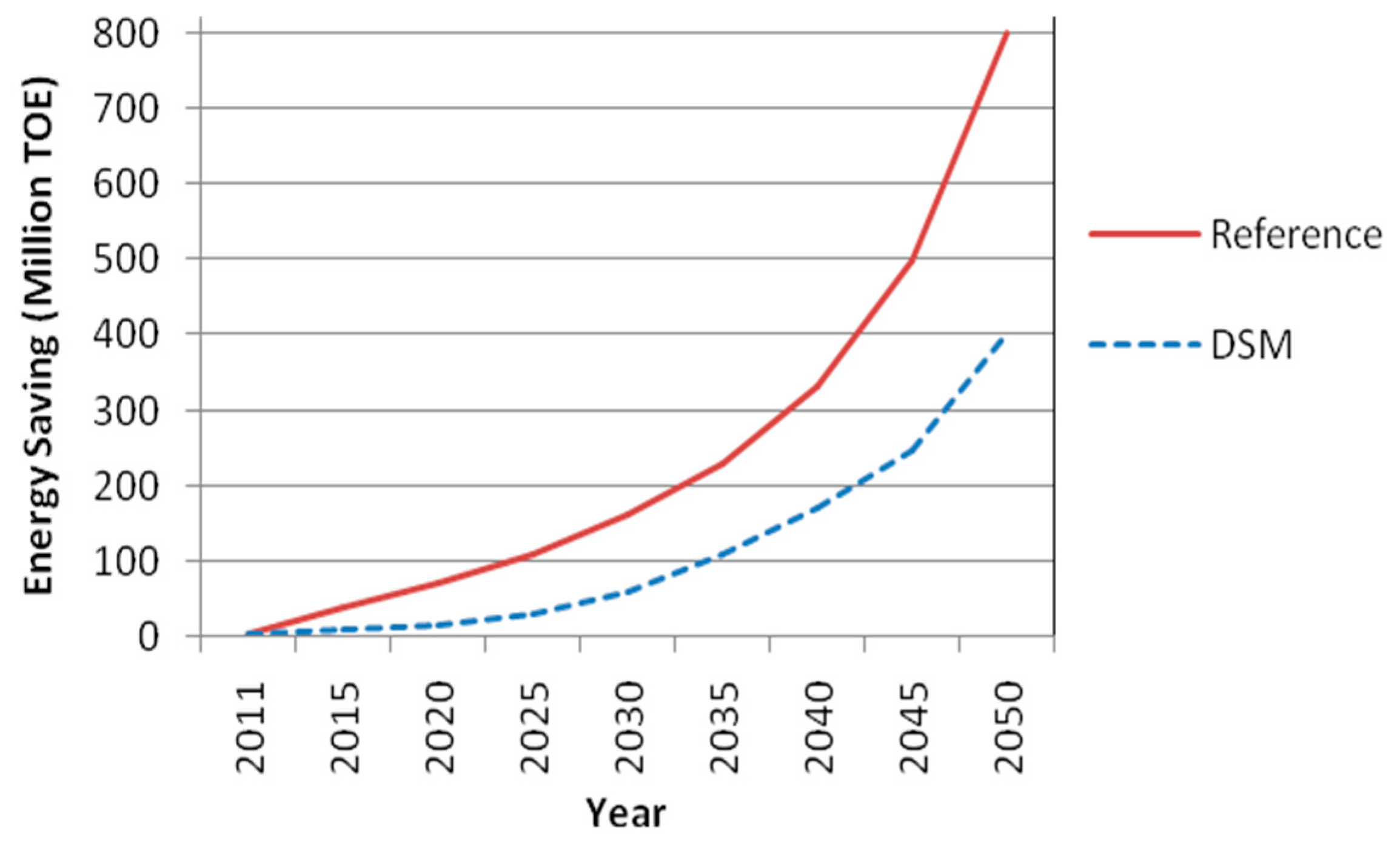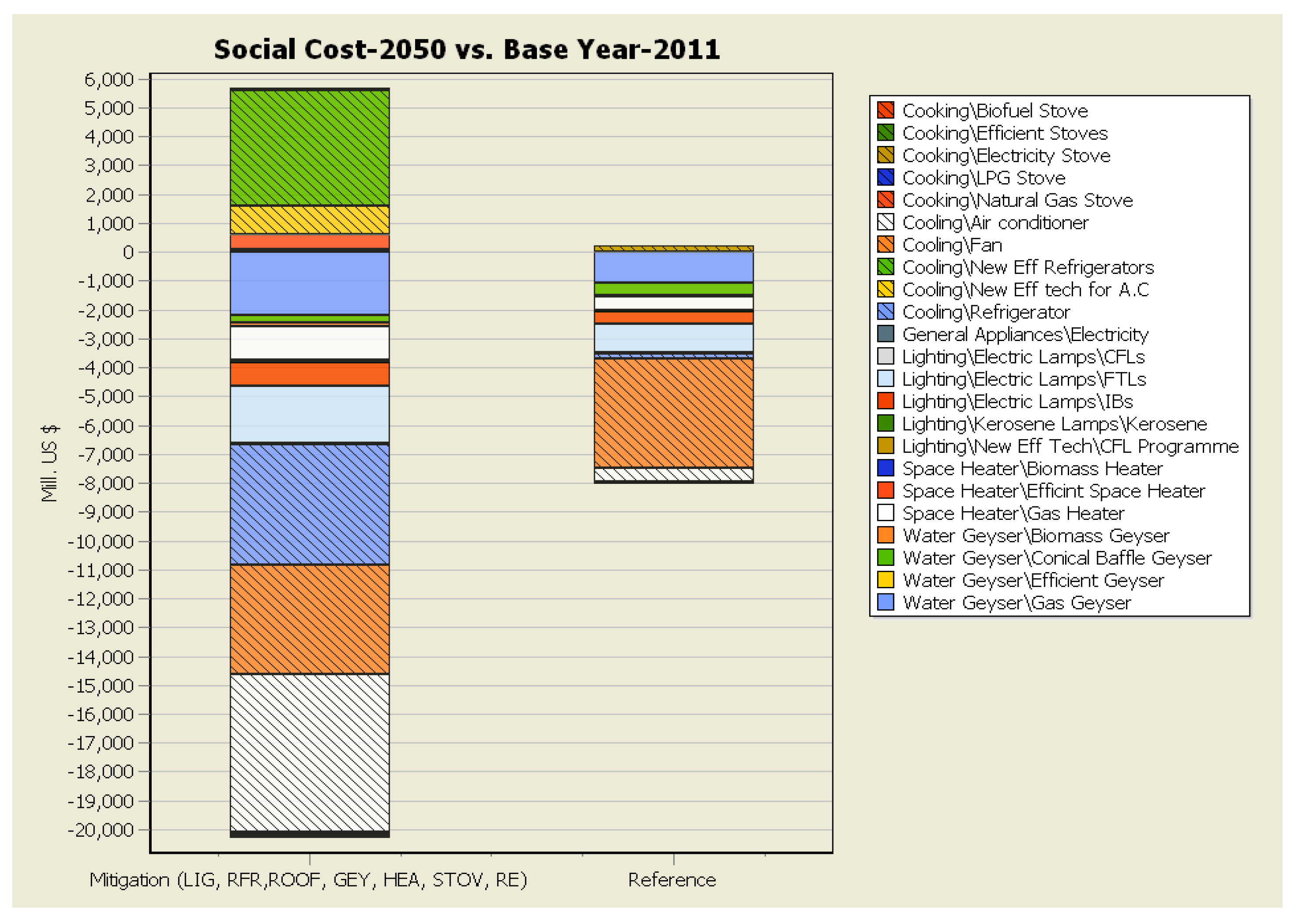Low-Emission Modeling for Energy Demand in the Household Sector: A Study of Pakistan as a Developing Economy
Abstract
1. Introduction
2. Materials and Methods
2.1. Mathematical Calculations
h m
h m f
2.2. Construction of Energy Policy Scenarios
2.2.1. Reference Scenario (REF)
- Rapid urbanization and excessive population growth in developing countries has resulted in haphazard and unplanned growth of big-city settlements. Under the usual scenario, the urban households are expected to increase at an annual growth rate of 3%.
- Increased access to electricity and natural gas will gradually decrease biomass and liquefied petroleum gas (LPG) consumption.
- With increasing income levels and government incentives for energy-efficient devices, people will shift toward less energy-intensive devices. This is interpreted as reduced energy intensities of existing devices per household.
- Transmission and distribution (T&D) losses will decrease.
2.2.2. Demand-Side Management Scenario (DSM)
2.2.3. Mitigation Scenario (MIT)
2.3. Economic Valuation of Scenarios
3. Results and Discussion
3.1. Results of Reference Scenario
3.2. Results of Demand-Side Management Scenario
3.3. Results of Mitigation Scenario
3.4. Economic Valuation of Alternative Policies/Scenarios
4. Conclusions
Author Contributions
Funding
Acknowledgments
Conflicts of Interest
References
- International Energy Agency. Energy Access Outlook 2017: From Poverty to Prosperity; International Energy Agency: Paris, France, 2017; Available online: https://www.iea.org/weo2017/ (accessed on 3 May 2018).
- World Bank. Tracking SDG7: The Energy Progress Report 2018; World Bank Publications; The World Bank Group: Washington, DC, USA, 2018; pp. 156–159. [Google Scholar]
- Pakistan Bureau of Statistics. Press Release on Provisional Summary Results of 6th Population and Housing Census—2017; Ministry of Statistics, Statistics Division, Government of Pakistan: Islamabad, Pakistan, 2017; pp. 1–2. Available online: http://www.pbs.gov.pk/content/provisional-summary-results-6th-population-and-housing-census-2017-0 (accessed on 16 August 2018).
- Government of Pakistan. Energy. In Pakistan Economic Survey 2016–2017; Adviser’s Wing, Finance Division, Government of Pakistan: Islamabad, Pakistan, 2017; Chapter 14; p. 143. [Google Scholar]
- World Health Organization. Accelerating SDG 7 Achievements, Policy Brief 10 Health and Energy Linkages-Maximizing Health Benefits from the Sustainable Energy Transition; United Nations Division for Sustainable Development Goals, Department of Economic and Social Affairs, United Nations: New York, NY, USA, 2018; p. 3. Available online: https://sustainabledevelopment.un.org/content/documents/17486PB10.pdf (accessed on 8 July 2018).
- International Energy Agency. World Energy Outlook 2013; International Energy Agency (IEA) Publications: Paris, France, 2013; pp. 19–22. ISBN 978-92-64-20130-9. Available online: http://www.worldenergyoutlook.org/weo2013/ (accessed on 5 May 2017).
- Ministry of Climate Change. Pakistan National GHG Inventory 2014–2015; Government of Pakistan: Islamabad, Pakistan, 2016; pp. 2–3.
- Punjab Economic Research Institute. Punjab Economic Report-2017; Publication No. 425; Planning and Development Department, Government of the Punjab: Lahore, Pakistan, 2017; p. 471.
- Shaaban, M.; Scheffran, J.; Böhner, J.; Elsobki, M.S. Sustainability Assessment of Electricity Generation Technologies in Egypt Using Multi-Criteria Decision Analysis. Energies 2018, 11, 1117. [Google Scholar] [CrossRef]
- Frederiks, E.R.; Stenner, K.; Hobman, E.V. The Socio-Demographic and Psychological Predictors of Residential Energy Consumption: A Comprehensive Review. Energies 2015, 8, 573–609. [Google Scholar] [CrossRef]
- Blázquez, L.; Boogen, N.; Filippini, M. Residential Electricity Demand in Spain: New Empirical Evidence Using Aggregate Data. Energy Econ. 2013, 36, 648–657. [Google Scholar] [CrossRef]
- Clark, M.L.; Peel, J.L.; Balakrishnan, K.; Breysse, P.N.; Chillrud, S.N.; Naeher, L.P.; Rodes, C.E.; Vette, A.F.; Balbus, J.M. Health and Household Air Pollution from Solid Fuel Use: The Need for Improved Exposure Assessment. Environ. Health Perspect. 2013, 121, 1120–1128. [Google Scholar] [CrossRef] [PubMed]
- Rosen, M.A. Energy Sustainability: A Pragmatic Approach and Illustrations. Sustainability 2009, 1, 55–80. [Google Scholar] [CrossRef]
- Yamamoto, Y.; Suzuki, A.; Fuwa, Y.; Sato, T. Decision-Making in Electrical Appliance Use in the Home. Energy Policy 2008, 36, 1679–1686. [Google Scholar] [CrossRef]
- Larsen, B.M.; Nesbakken, R. Household Electricity End-Use Consumption: Results from Econometric and Engineering Models. Energy Econ. 2004, 26, 179–200. [Google Scholar] [CrossRef]
- Farhad, D.R. On Sustainability in Local Energy Planning [Doctoral Dissertation]; Division of Efficient Energy Systems, Tryckeriet E-huset Lund University: Lund, Sweden, 2011; pp. 34–73. ISBN 978-91-7473-110-1. [Google Scholar]
- OECD/IEA. Real-World Policy Packages for Sustainable Energy Transitions Shaping Energy Transition Policies to Fit National Objectives and Constraints; International Energy Agency: Paris, France, 2017. [Google Scholar]
- Heaps, C.G. Long-Range Energy Alternatives Planning (LEAP) System; Stockholm Environment Institute: Somerville, MA, USA, 2016; Available online: https://www.energycommunity.org (accessed on 5 February 2015).
- Supasa, T.; Hsiau, S.; Lin, S.; Wongsapai, W.; Chang, K.; Wu, J. Sustainable Energy and CO2 Reduction Policy in Thailand: An Input-Output Approach from Production-and Consumption-Based Perspectives. Energy Sustain. Dev. 2017, 41, 36–48. [Google Scholar] [CrossRef]
- Ahmad, A.; Khan, A.; Javaid, N.; Hussain, H.M.; Abdul, W.; Almogren, A.; Alamri, A.; Niaz, I.A. An Optimized Home Energy Management System with Integrated Renewable Energy and Storage Resources with Integrated Renewable Energy and Storage Resources. Energies 2017, 10, 549. [Google Scholar] [CrossRef]
- Chaudhry, A.A. A Panel Data Analysis of Electricity Demand in Pakistan. Lahore J. Econ. 2010, 15, 7. [Google Scholar]
- Phdungsilp, A. Integrated Energy and Carbon Modeling with a Decision Support System: Policy Scenarios for Low-Carbon City Development in Bangkok. Energy Policy 2010, 38, 4808–4817. [Google Scholar] [CrossRef]
- Sheikh, M.A. Energy and Renewable Energy Scenario of Pakistan. Renew. Sustain. Energy Rev. 2010, 14, 354–363. [Google Scholar]
- Chaudhry, T. Estimating Residential Electricity Demand Responses in Pakistan’s Punjab. Lahore J. Econ. 2010, 15, 109–110. [Google Scholar]
- Avami, A.; Farahmandpour, B. Analysis of Environmental Emissions and Greenhouse Gases in Islamic Republic of Iran. WSEAS Trans. Environ. Dev. 2008, 4, 303–312. [Google Scholar]
- McNeil, M.A.; Letschert, V.E. Forecasting Electricity Demand in Developing Countries: A Study of Household Income and Appliance Ownership. In Proceedings of the European Council for Energy Efficient Economy (ECEEE) Summer Study 2005, Mandelieu la Napoule, France, 30 May–4 June 2005. [Google Scholar]
- El-Fadel, M.; Zeinati, M.; Ghaddar, N.; Mezher, T. Mitigating Energy-Related GHG Emissions through Renewable Energy. Energy Policy 2001, 29, 1031–1043. [Google Scholar] [CrossRef]
- Ghanadan, R.; Koomey, J.G. Using Energy Scenarios to Explore Alternative Energy Pathways in California. Energy Policy 2005, 33, 1117–1142. [Google Scholar] [CrossRef]
- World Resources Institute. NDC Country Outlook-Pakistan 2017; NDC Partnership Support Unit, World Resources Institute: Washington, DC, USA, 2017; pp. 1–7. Available online: https://ndcpartnership.org/sites/all/themes/ndcp_v2/docs/country-engagement/countries/NCDP_Outlook_Pakistan_v6a.pdf (accessed on 17 August 2017).
- Pakistan Bureau of Statistics. Brief on Pakistan Social & Living Standard Measurement (PSLM) Survey 2004–2015. Available online: http://www.pbs.gov.pk/content/pakistan-social-and-living-standards-measurement (accessed on 27 October 2017).
- Ministry of Environment. National Environmental Policy—2005; Government of Pakistan: Islamabad, Pakistan, 2005.
- Pakistan Bureau of Statistics. Compendium on Environmental Statistics of Pakistan, 2015. Available online: http://www.pbs.gov.pk/sites/default/files//crops_and_climates/compendium_environment/compendium_environment_2015.pdf (accessed on 11 April 2016).
- Gallup Pakistan Limited. Trends in the Use of Electric Goods in Pakistan, 2015. Available online: http://gallup.com.pk/trends-in-the-use-of-electric-goods-in-pakistan-2/ (accessed on 3 January 2016).
- World Energy Council. Climate Change: Implications for the Energy Sector, Key Findings from the Intergovernmental Panel on Climate Change Fifth Assessment Report; World Energy Council: London, UK, 2014; Available online: http://www.worldenergy.org/wp-content/uploads/2014/06/Climate-Change-Implications-for-the-Energy-Sector-Summary-from-IPCC-AR5-2014-Full-report.pdf (accessed on 3 March 2016).
- Asian Development Bank (ADB). Asian Development Outlook 2012: Confronting Rising Inequality in Asia; Asian Development Bank: Mandaluyong City, Philippines, 2012; pp. 180–181. ISBN 978-92-9092-606-1. [Google Scholar]
- Asian Development Bank (ADB). Proposed Multi-Tranche Financing Facility and Administration of Co-Financing Islamic Republic of Pakistan; Project No. 42051; Report and Recommendation of the President to the Board of Directors; Energy Efficiency Investment Program, Asian Development Bank: Mandaluyong, Philippines, 2009; pp. 2–4. [Google Scholar]
- Hagler & Bailly; Econoler International. Pakistan Sustainable Energy Efficiency Development Program; Project No. ADB TA 7060-PAK, ADB Technical Assistance Consultant’s Final Report; Asian Development Bank: Islamabad, Pakistan, 2009; pp. 90–96. Available online: https://www.adb.org/sites/default/files/project-document/64867/42051-PAK-TACR.pdf (accessed on 15 May 2014).
- Khan, M.A.A.; Amir, P.; Ramay, S.A.; Munawar, Z.; Ahmad, V. National Economic and Environmental Development Study (NEEDS) Report of Pakistan; UNFCCC: Islamabad, Pakistan, 2011; pp. 12–65. Available online: https://unfccc.int/files/adaptation/application/pdf/pakistanneeds.pdf (accessed on 4 May 2014).
- Snc Inc. Lavalin International; National Engineering Services Pakistan (Pvt) Limited. Power System Statistics 2016–2017, 42nd ed.; Power System Planning, National Transmission and Dispatch Company Ltd.: Lahore, Pakistan, 2017; pp. 15–31. Available online: http://www.ntdc.com.pk/Files/ps42ed.pdf (accessed on 28 August 2018).
- Saxenaa, V.; Bhattacharya, P.C. Inequalities in LPG and Electricity Consumption in India: The Role of Caste, Tribe, and Religion. Energy Sustain. Dev. 2018, 42, 44–53. [Google Scholar] [CrossRef]
- Hafeez, G.; Javaid, N.; Iqbal, S.; Khan, F.A. Optimal Residential Load Scheduling under Utility and Rooftop Photovoltaic Units. Energies 2018, 11, 611. [Google Scholar] [CrossRef]
- German Centre for Sustainability (IGCS). Long-Term Energy and Development Pathways for India; Shakti Sustainable Energy Foundation, IGCS, IIT: Chennai, India, 2014; p. 2. [Google Scholar]
- Amirnekooei, K.; Ardehali, M.; Sadri, A. Integrated Resource Planning for Iran: Development of Reference Energy System, Forecast and Long-Term Energy-Environment Plan. Energy 2012, 46, 374–385. [Google Scholar] [CrossRef]
- Von Hippel, D.E.P.; Tempest, K.L.M. Strategies for Development of Green Energy Systems in Mongolia Final Report; Global Green Growth Institute: Seoul, Korea, 2014; pp. 5–9. [Google Scholar]
- McPherson, M.; Karney, B. Long-Term Scenario Alternatives and Their Implications: LEAP Model Application of Panama’s Electricity Sector. Energy Policy 2014, 68, 146–157. [Google Scholar] [CrossRef]
- Phdungsilp, A.; Wuttipornpun, T. Energy and Carbon Modeling with Multi-Criteria Decision-Making towards Sustainable Industrial Sector Development in Thailand. Low Carbon Econ. 2011, 2, 165–172. [Google Scholar] [CrossRef]
- Park, N.B.; Yun, S.J.; Chan, J.E. An Analysis of Long-Term Scenarios for the Transition to Renewable Energy in the Korean Electricity Sector. Energy Policy 2013, 52, 288–296. [Google Scholar] [CrossRef]
- Nadia, S.O. Africa Energy Future: Alternative Scenarios and Their Implications for Sustainable Development Strategies. Energy Policy 2017, 106, 457–471. [Google Scholar] [CrossRef]
- Xing, R.; Hanaoka, T.; Kanamori, Y.; Masui, T. Greenhouse Gas and Air Pollutant Emissions of China’s Residential Sector: The Importance of considering Energy Transition. Sustainability 2017, 9, 614. [Google Scholar] [CrossRef]
- Erum, S.; Ahmad, S.S. Energy Demand and Emission Analysis of Islamabad Industrial Area using Energy Model. World Appl. Sci. J. 2010, 8, 900–905. [Google Scholar]
- Shabbir, R.; Ahmad, S.S. Monitoring Urban Transport Air Pollution and Energy Demand in Rawalpindi and Islamabad using LEAP Model. Energy 2010, 35, 2323–2332. [Google Scholar] [CrossRef]
- Gul, M.; Qureshi, W.A. Modeling Diversified Electricity Generation Scenarios for Pakistan. In Proceedings of the IEEE Power and Energy Society General Meeting, San Diego, CA, USA, 22–26 July 2012; pp. 1–7. [Google Scholar]
- Mengal, A.; Harijan, K.; Uqaili, M.A.; Mirjat, N.H. Electricity Demand and Emissions under Different Policy Scenarios for Pakistan. In Proceedings of the 3rd International Conference on Energy, Environment and Sustainable Development (EESD 2014), Jamshoro, Pakistan, 22–24 October 2014. [Google Scholar]
- Syed, M.S.; Chaudhry, I.A.; Farooq, M.; Qamar, A. Modeling and Forecasting of Energy Scenario in Pakistan with Application of Decentralized Energy Planning. J. Fac. Eng. Technol. 2014, 21, 9–22. [Google Scholar]
- Perwez, U.; Sohail, A.; Hassan, S.F.; Zia, U. The Long-Term Forecast of Pakistan’s Electricity Supply and Demand: An Application of Long Range Energy Alternatives Planning. Energy 2015, 93, 2423–2435. [Google Scholar] [CrossRef]
- Gupta, G.; Kohlin, G. Preferences for Domestic Fuel: Analysis with Socioeconomic Factors and Rankings in Kolkata, India. Ecol. Econ. 2006, 57, 107–121. [Google Scholar] [CrossRef]
- Farsi, M.; Filipini, M.; Pachauri, S. Fuel Choices in Urban Indian Households. Environ. Dev. Econ. 2007, 12, 757–774. [Google Scholar] [CrossRef]
- Hosier, R.H.; Dowd, J. Household Fuel Choice in Zimbabwe: An Empirical Test of the Energy Ladder Hypothesis. Resour. Energy 1987, 9, 347–361. [Google Scholar] [CrossRef]
- Davis, M. Rural Household Energy Consumption: The Effects of Access to Electricity-Evidence from South Africa. Energy Policy 1998, 26, 207–217. [Google Scholar] [CrossRef]
- Zhao, C.-S.; Niu, S.W.; Zhang, X. Effects of Household Energy Consumption on Environment and Its Influence Factors in Rural and Urban Areas. Energy Procedia 2012, 14, 805–811. [Google Scholar]
- Aqeel, A.; Butt, M.S. The Relationship between Energy Consumption and Economic Growth in Pakistan. Asia-Pac. Dev. J. 2001, 8, 101–110. [Google Scholar]
- Shahbaz, M.; Zeshan, M.; Afza, T. Is Energy Consumption Effective to Spur Economic Growth in Pakistan? New Evidence from Bounds Test to Level Relationships and Granger Causality Tests. Econ. Model. 2012, 29, 2310–2319. [Google Scholar] [CrossRef]
- Khan, M.A.; Ahmad, U. Energy Demand in Pakistan: A Disaggregate Analysis. Pak. Dev. Rev. 2008, 47, 437–455. [Google Scholar] [CrossRef]
- Siddiqui, R. Energy and Economic Growth in Pakistan. Pak. Dev. Rev. 2004, 43, 175–200. [Google Scholar] [CrossRef]
- Shahbaz, M.; Lean, H.H. The Dynamics of Electricity Consumption and Economic Growth: A Revisit Study of Their Causality in Pakistan. Energy 2012, 39, 146–153. [Google Scholar] [CrossRef]
- Hye, Q.M.A.; Riaz, S. Causality between Energy Consumption and Economic Growth: The Case of Pakistan. Lahore J. Econ. 2008, 13, 45–58. [Google Scholar]
- Zaman, K.; Khan, M.M.; Ahmad, M.; Rustam, R. Determinants of Electricity Consumption Function in Pakistan: Old Wine in a New Bottle. Energy Policy 2012, 50, 623–634. [Google Scholar] [CrossRef]
- Raza, S.A.; Shahbaz, M.; Nguyen, D.K. Energy Conservation Policies, Growth and Trade Performance: Evidence of Feedback Hypothesis in Pakistan. Energy Policy 2015, 80, 1–10. [Google Scholar] [CrossRef]
- Ahmed, K.; Shahbaz, M.; Qasim, A.; Long, W. The Linkages between Deforestation, Energy and Growth for Environmental Degradation in Pakistan. Ecol. Indic. 2015, 49, 95–103. [Google Scholar] [CrossRef]
- Komal, R.; Abbas, F. Linking Financial Development, Economic Growth and Energy Consumption in Pakistan. Renew. Sustain. Energy Rev. 2015, 44, 211–220. [Google Scholar] [CrossRef]
- Shahbaz, M.; Lean, H.H.; Farooq, A. Natural Gas Consumption and Economic Growth in Pakistan. Renew. Sustain. Energy Rev. 2013, 18, 87–94. [Google Scholar] [CrossRef]
- Shahbaz, M.; Loganathan, N.; Zeshan, M.; Zaman, K. Does Renewable Energy Consumption Add in Economic Growth? An Application of Auto-Regressive Distributed Lag Model in Pakistan. Renew. Sustain. Energy Rev. 2015, 44, 576–585. [Google Scholar] [CrossRef]
- Arshad, A.; Zakaria, M.; Junyang, X. Energy Prices and Economic Growth in Pakistan: A Macro-Econometric Analysis. Renew. Sustain. Energy Rev. 2016, 55, 25–33. [Google Scholar] [CrossRef]
- Zeng, Y.; Cai, Y.; Huang, G.; Dai, J. A Review on Optimization Modeling of Energy Systems Planning and GHG Emission Mitigation under Uncertainty. Energies 2011, 4, 1624–1656. [Google Scholar] [CrossRef]
- Alam, S.; Fatima, A.; Butt, M.S. Sustainable Development in Pakistan in the Context of Energy Consumption Demand and Environmental Degradation. J. Asian Econ. 2007, 18, 825–837. [Google Scholar] [CrossRef]
- Nasir, M.; Ur Rehman, F. Environmental Kuznets Curve for Carbon Emissions in Pakistan: An Empirical Investigation. Energy Policy 2011, 39, 1857–1864. [Google Scholar] [CrossRef]
- Ali, G.; Abbas, S. Exploring CO2 Sources and Sinks Nexus through Integrated Approach: Insight from Pakistan. J. Environ. Inform. 2013, 12, 112–122. [Google Scholar]
- Rehman, S.A.U.; Cai, Y.; Fazal, R.; Das Walasai, G.; Mirjat, N.H. An Integrated Modeling Approach for Forecasting Long-Term Energy Demand in Pakistan. Energies 2017, 10, 1868. [Google Scholar] [CrossRef]
- Hydrocarbon Development Institute of Pakistan (HDIP). Energy Year Book 2016–2017; Ministry of Petroleum and Natural Resources, Government of Pakistan: Islamabad, Pakistan, 2017; pp. 15–45.
- National Energy Conservation Centre (ENERCON). Energy Efficient Lighting—A Triple Win for People, Environment and the Economy; ENERCON, Government of Pakistan: Islamabad, Pakistan, 2009. Available online: https://sari-energy.org/oldsite/PageFiles/What_We_Do/activities/RCEEL/presentations/Pakistan-CaseStudiesonEnergyEfficientLighting.pdf (accessed on 9 February 2011).
- Kojima, M. Pakistan Household Use of Commercial Energy; Report 320/06; Energy Sector Management Assistance Program (ESMAP) c/o Energy and Water Department, the World Bank Group: Washington, DC, USA, 2006; pp. 9–75. Available online: http://climateinfo.pk/frontend/web/attachments/data-type/ESMAP%20(2006)%20Pakistan%20Household%20Use%20of%20Commercial%20Energy.pdf (accessed on 12 May 2016).
- Yale University. 2018 Environmental Performance Index. Available online: https://epi.envirocenter.yale.edu/downloads/epi2018policymakerssummaryv01.pdf (accessed on 3 August 2018).
- Mekonnen, M.M.; Gerbens-Leenes, P.W.; Hoekstra, A.Y. Future Electricity: The Challenge of Reducing both Carbon and Water Footprint. Sci. Total Environ. 2016, 569–570, 1282–1288. [Google Scholar] [CrossRef] [PubMed]
- Cellura, M.; Cusenza, M.A.; Longo, S. Energy-Related GHG Emissions Balances: IPCC versus LCA. Sci. Total Environ. 2018, 628–629, 1328–1339. [Google Scholar] [CrossRef] [PubMed]
- Lahmeyer International GmbH; IPEK Energy GmbH. Environmental Impact Assessment of 50MW FFC Wind Power Plant Jhimpir; Report No. TD-06-401-2 (Revision-04); Fauji Fertilizer Company Limited: Rawalpindi, Pakistan, 2008; pp. 19–25. [Google Scholar]
- Tahir, Z.R.; Asim, M. Surface Measured Solar Radiation Data and Solar Energy Resource Assessment of Pakistan: A Review. Renew. Sustain. Energy Rev. 2017, 81 Pt 2, 2839–2861. [Google Scholar] [CrossRef]








| Socio-Economic Characteristics: |
|
Energy Demand Data:
| Fuel Use by Sector or Subsector:
|
Energy Supply Data:
|
|
Technology Options:
|
|
| Policy Measure | Description |
|---|---|
| Efficient Lighting |
|
| Efficient Cooking |
|
| Efficient Space Heating |
|
| Efficient Water Geysers |
|
| Efficient Cooling |
|
| T&D Loss Reduction |
|
| DEVICE | 2011 | 2015 | 2020 | 2025 | 2030 | 2035 | 2040 | 2045 | 2050 |
|---|---|---|---|---|---|---|---|---|---|
| Bio-fuel Stove | 0 | −0.1 | −0.2 | −0.3 | −0.5 | −0.7 | −1 | −1.4 | −1.8 |
| Electricity Stove | 0 | 0.2 | 0.6 | 1 | 1.7 | 2.5 | 3.5 | 4.9 | 6.6 |
| LPG Stove | 0 | 0 | −0.1 | −0.1 | −0.2 | −0.2 | −0.3 | −0.5 | −0.6 |
| Natural Gas Stove | 0 | 0 | −0.1 | −0.2 | −0.3 | −0.6 | −0.9 | −1.3 | −1.9 |
| Air conditioner | 0 | −0.1 | −0.2 | −0.4 | −0.8 | −1.3 | −2.1 | −3.4 | −5.2 |
| Fan | 0 | 0 | 0 | 0 | 0 | 0 | 0 | 0 | 0 |
| Refrigerator | 0 | −0.3 | −1 | −2.6 | −6.1 | −13.2 | −27.7 | −56.8 | −114.6 |
| Electric Lamps | 0 | 0 | −0.1 | −0.1 | −0.2 | −0.2 | −0.3 | −0.4 | −0.5 |
| Kerosene Lamps | 0 | 0 | 0 | 0 | 0 | 0 | 0 | 0 | 0 |
| Biomass Heater | 0 | 0 | 0 | 0 | 0 | 0 | 0 | 0 | 0 |
| Gas Heater | 0 | 0 | 0 | 0.1 | 0.1 | 0.1 | 0.1 | 0.2 | 0.2 |
| Biomass Geyser | 0 | 0 | 0 | −0.1 | −0.1 | −0.2 | −0.3 | −0.4 | −0.5 |
| Efficient Geyser | 0 | 0.2 | 0.6 | 1 | 1.6 | 2.3 | 3.2 | 4.4 | 5.8 |
| Existing Geyser | 0 | −29.1 | −82.6 | −160.7 | −195 | −237.9 | −291.7 | −359.1 | −443.3 |
| TOTAL | 0 | −29.2 | −83 | −162.5 | −199.8 | −249.6 | −317.5 | −413.7 | −555.8 |
| DSM versus REF | Cumulative Costs |
|---|---|
| Net Present Value | −157.3 |
| GHG Savings (M.T.CO2e) | 46,932.6 |
| Cost of Avoided CO2 (US $/Tonne CO2e) | −3.4 |
© 2018 by the authors. Licensee MDPI, Basel, Switzerland. This article is an open access article distributed under the terms and conditions of the Creative Commons Attribution (CC BY) license (http://creativecommons.org/licenses/by/4.0/).
Share and Cite
Bashir, S.; Ahmad, I.; Rashid Ahmad, S. Low-Emission Modeling for Energy Demand in the Household Sector: A Study of Pakistan as a Developing Economy. Sustainability 2018, 10, 3971. https://doi.org/10.3390/su10113971
Bashir S, Ahmad I, Rashid Ahmad S. Low-Emission Modeling for Energy Demand in the Household Sector: A Study of Pakistan as a Developing Economy. Sustainability. 2018; 10(11):3971. https://doi.org/10.3390/su10113971
Chicago/Turabian StyleBashir, Sana, Iftikhar Ahmad, and Sajid Rashid Ahmad. 2018. "Low-Emission Modeling for Energy Demand in the Household Sector: A Study of Pakistan as a Developing Economy" Sustainability 10, no. 11: 3971. https://doi.org/10.3390/su10113971
APA StyleBashir, S., Ahmad, I., & Rashid Ahmad, S. (2018). Low-Emission Modeling for Energy Demand in the Household Sector: A Study of Pakistan as a Developing Economy. Sustainability, 10(11), 3971. https://doi.org/10.3390/su10113971




